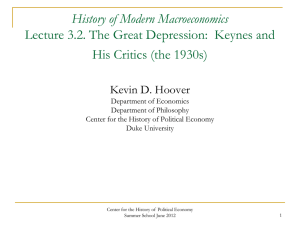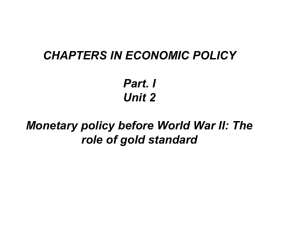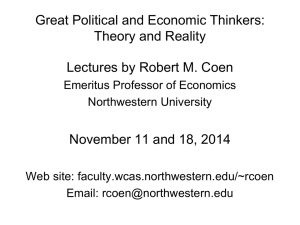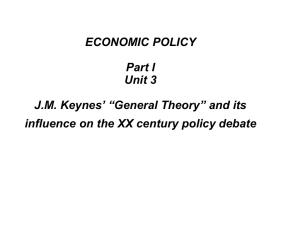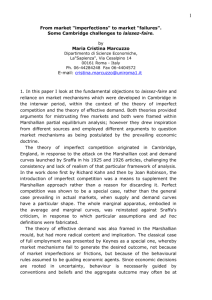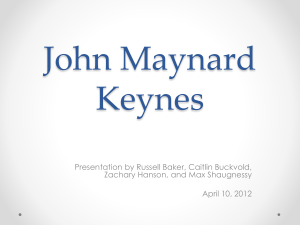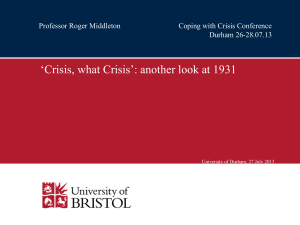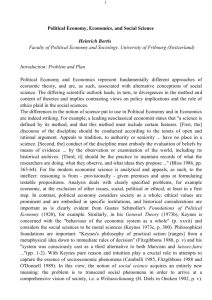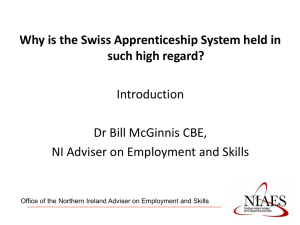Presentation_Nov_11_B
advertisement
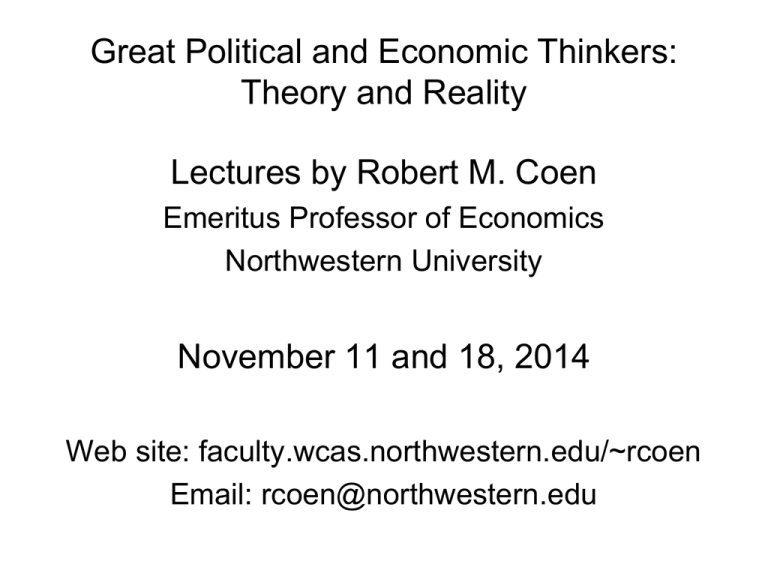
Great Political and Economic Thinkers: Theory and Reality Lectures by Robert M. Coen Emeritus Professor of Economics Northwestern University November 11 and 18, 2014 Web site: faculty.wcas.northwestern.edu/~rcoen Email: rcoen@northwestern.edu November 11 20th Century Revolution in Economic Thinking: John Maynard Keynes November 18 Counterrevolution to Keynes and Critiques of Activist Economic Policies: Hayek, Friedman, Lucas, and Others 20th Century Revolution in Economic Thinking: John Maynard Keynes Story inside: “Man of the Moment: Why John Maynard Keynes is just the economist we need to get the world’s economy humming again” by Peter Coy Bloomberg Businessweek cover, Nov. 3, 2014 Major Questions to be Addressed What was the state of economic thought at the turn of the 20th century? What made economics ripe for a revolution? What were Keynes’s revolutionary ideas? Why was Keynes such an effective revolutionary leader? What led to the decline of Keynesianism beginning in the 1970’s? Why is Keynes back on the cover of Bloomberg Businessweek? Major Questions to be Addressed What was the state of economic thought at the turn of the 20th century? Frederick S. Deibler, 1876-1961 NU Professor of Economics and Commerce, 1914-42 Chair of Economics, 1916-42 Secretary-Treasurer of the American Economic Association, 1925-36 Endowed Deibler Awards in Economics Principles of Economics (1929, 2nd ed. 1936)) Contributor to Society Today (1929), “The Future of Our Economic System” Society Today (1929) Baker Brownell, ed. Vol. 5 of Man and His World: Northwestern University Essays in Contemporary Thought Brownell taught editorial writing, philosophy and contemporary thought Society Today series drew on his innovative course on thought Other contributors to Vol. 5: Edwin E Slosson, chemist, science writer “The Energy of the New World” Walter Dill Scott, psychologist, NU President 1920-39 “The New Energies and the New Man” Willard E. Hotchkiss, NU Commerce Dean 1908-17, then Stanford 1925-32 “Business in the New Era” Stuart Chase, economist, social theorist and reformer “Consumers in the Modern World” Economics at NU, circa 1925 Basic Texts: Irving Fisher, Principles of Economics T. N. Carver, Distribution of Wealth Henry George, Progress and Poverty Largely limited to “Microeconomics” – analysis of value, production, distribution No courses comparable to today’s “Macroeconomics” - business cycles Macroeconomics doesn’t arrive until 1952 (Robert Eisner) Key macroeconomic concepts, e.g., GDP and National Income, not yet devised Money, banking, and finance only macro-related course No mention of Karl Marx in Deibler’s text Passing reference to Keynes on economics as a science Most cited are Alfred Marshall and Irving Fisher Economic Orthodoxy circa 1929 Basic Tenets Inflation caused by increase in money supply Governments tempted to print too much money Fluctuations in production unavoidable, desirable Persistent unemployment due to excessive wages Major Policy Implications Back money with gold to maintain confidence in currency Require government to balance budget Eliminate temptation to print money Allow business cycles to run their course Don’t interfere with creative destruction of free market Keep wages and prices flexible; promote competition The “Classical Quartet” of Economics Adam Smith, 1723-1790 Thomas Malthus, 1766-1834 David Ricardo, 1772-1823 John Stuart Mill, 1806-1873 The “Neoclassical Duo” of Economics Alfred Marshall, 1842-1924 Irving Fisher, 1867-1947 Irving Fisher, 1867-1947 • • • • • • • • • Genius - America’s greatest economist? Trained in physics and math, but “renaissance man” Yale PhD (math) – pure economics Taught at Yale entire life President of AEA, 1918 Co-founder of Econometric Society, 1930, first president Congenital reformer, inveterate crusader Inventor Non-economic activism – – – – – • Prohibition Vegetarianism Fresh air and exercise Eugenics Peace, League of Nations Reputation ruined by 1929 crash Supply and Demand Diagram What Made Economics Ripe for a Revolution Post WWI? Instability of free-market capitalism US Growth Rate, Real GDP per Capita, 1791-1929 (percent) 15 10 Percent 5 0 -5 -10 -15 00 10 20 30 40 50 60 Year Source: S.H. Williamson, MeasuringWorth, 2014 70 80 90 00 10 20 US Inflation Rate, 1791-1929 (percent) 30 Percent 20 10 0 -10 -20 00 10 20 30 40 50 60 Year Source: S.H. Williamson, MeasuringWorth, 2014 70 80 90 00 10 20 US Growth Rate, Real GDP per Capita, 1791-2013 (percent) 15 10 Percent 5 0 -5 -10 -15 1800 1825 1850 1875 1900 Year Source: S.H. Williamson, MeasuringWorth, 2014 1925 1950 1975 2000 US Inflation Rate, 1791-2013 (percent) 30 Percent 20 10 0 -10 -20 1800 1825 1850 1875 1900 Year Source: S.H. Williamson, MeasuringWorth, 2014 1925 1950 1975 2000 US Growth and Inflation Pre-Keynes and Post-Keynes Growth Rate of Real GDP per Capita (percent) Pre-Keynes Min 1791-1929 Average StDev Max 1.5 3.9 11.6 (1916) -13.4 (1908) Post-Keynes 1947-2013 1.9 2.2 6.7 (1950) -3.7 (2009) Inflation Rate (percent) Pre-Keynes Min 1791-1929 Average StDev Max 0.6 6.1 21.0 (1917) -16.3 (1802) Post-Keynes 1947-2013 3.3 2.3 10.4 (1947) -0.2 (1953) Post-Keynes: Higher, more stable growth; higher, more stable inflation The Great Depression 1929 1932 Real GDP (2005 prices) %change 977.0 725.8 -25.7 34.1 25.1 -26.4 2.9 22.9 +20.9 Price level (1929=100) 100.0 76.7 -23.3 Consumer spending 736.6 614.7 -16.5 Investment spending 101.7 12.9 -87.3 38.0 20.4 -46.3 Employment (private) Unemployment rate Exports What Made Economics Ripe for a Revolution Post WWI? Instability of free-market capitalism Stagnation of the UK Financial, trade, and unemployment problems in Europe UK and US Real GDP, 1870-1939 Indexes, 1870=100 320 280 Index 240 200 160 120 80 70 75 80 85 90 95 00 05 Year Source: S.H. Williamson, MeasuringWorth, 2014. 10 15 20 25 UK 30 35 US US and UK Prices Levels, 1870-1939 Indexes, 1870=100 300 250 Index 200 150 100 50 70 75 80 85 90 95 00 05 Year Source: S.H. Williamson, MeasuringWorth, 2014. 10 15 20 25 30 UK 35 US Real GDP per Capita of World Leader (1990 dollars; leader in red) 1820 1870 1913 1950 Netherlands 1,838 2,757 4,049 5,996 UK 1,706 3,190 4,921 6,939 US 1,257 2,445 5,301 9,561 1.8 8.9 18.9 27.3 US share of world GDP Source: Angus Maddison, Contours of the World Economy, 2-2030AD What Made Economics Ripe for a Revolution Post WWI? Instability of free-market capitalism Stagnation of the UK Financial, trade, and unemployment problems in Europe Conventional policy prescriptions not working Maintain the gold standard Government should balance budget Allow business cycles to run their course Keep wages and prices flexible; promote competition New proposals, e.g., public works spending, lacked theoretical justification Marxian Revolution posing challenge to capitalism Life of John Maynard Keynes 1883: Born to John Neville Keynes, economics lecturer at Cambridge, and Florence Ada Keynes, one of the first female Cambridge graduates (Newnham) 1897-1902: Studied at Eton, excelling in math, but also writing and debate 1902-1905: Undergrad at King’s College, Cambridge, first class in math; read Marshall’s Principles and studied with Marshall 1906: Takes Civil Service exams, tops in political science, logic, philosophy, essay; worst scores in math and econ! 1906-1907: Civil Service position, London India Office. Revenue, Statistics, and Commerce Dept; studied probability theory on the side 1908-1909: Completed dissertation on probability theory at Cambridge, elected fellow of King’s Colllege, lectured on money, credit and prices 1911: Appointed editor of the Economics Journal Life of John Maynard Keynes 1913: Published Indian Currency and Finance, joins Royal Commission on Indian Finance and Currency 1915: Joined Treasury to advise Lloyd George on war finance, moved up quickly and designed system of war loans 1917-18: Took authority at Treasury for inter-allied economic effort, made estimates of German capacity for reparations payments; left Treasury to return to Cambridge to lecture and write 1919: Published The Economic Consequences of the Peace, a sharp indictment of the excessive reparations imposed on Germany by the Versailles Treaty 1921: Published Treatise on Probability 1922: Published A Revision of the Treaty, again arguing for reduction in German reparations; published lengthy supplements on Europe’s economies in the Manchester Guardian arguing for currency devaluations 1923: Published A Tract on Monetary Reform, calling for end to the Gold Standard The Gold Standard Quantity theory of money: MV = PY V determined by financial practices Y determined by resources and technology Price level rises when money supply increases Each nation pledges to redeem its currency for gold at a fixed price Issue of currency tied to government holdings of gold World money supply rises with new gold discoveries If imports exceed exports, nation loses gold → money supply contracts, price level falls → stimulates exports, reduces imports → trade automatically rebalanced The Gold Standard Quantity theory of money: MV = PY V determined by financial practices Y determined by resources and technology Price level rises when money supply increases Each nation pledges to redeem its currency for gold at a fixed price Issue of currency tied to government holdings of gold World money supply rises with new gold discoveries If imports exceed exports, nation loses gold → money supply contracts, price level falls → stimulates exports, reduces imports → trade automatically rebalanced Life of John Maynard Keynes 1924: Published Does Unemployment Need a Drastic Remedy? in the Nation, proposing large government outlays on housing, roads, and electric power to stimulate the economy 1924: Delivered Ball Foundation Lecture at Cambridge, titled it The End of Laissez-Faire 1925: Married Lydia Lopokova, Russian ballerina 1929: Joined government’s Macmillan Committee of Enquiry into Finance and Industry 1930: Joined the Economic Advisory Council to evaluate economic policy; wrote in the Nation, “We are now in the depths of a very severe international slump which will take its place in history amongst the most acute ever experienced. It will require not merely passive movements of bank rates to lift us out of a depression of this order, but a very active and determined policy.” 1930: Published A Treatise on Money, arguing that the correct action in economic depression is to encourage spending and discourage saving, contrary to conventional wisdom Life of John Maynard Keynes 1931: Visited the US Federal Reserve and President Hoover 1931: Finally won long-running argument with British Government to abandon Gold Standard and devalue sterling 1934: Published an open letter to President Roosevelt in NY Times warning (1) to focus on economic recovery not economic reform (set aside NRA) and (2) avoid “crackedbrained” advice about how to stimulate recovery. 1936: Published The General Theory of Employment, Interest, and Money 1939: Turned down offer to be member of Parliament for Cambridge University to remain free to take his own stances on issues 1940: Published How to Pay for the War, proposing low interest rates, compulsory savings (deferred pay) to prevent inflation (like that in WWI); moved to the Treasury as an adviser Life of John Maynard Keynes 1941: Made first of several important visits to America to negotiate on Britain’s behalf, including Lend-Lease 1942-44: Made proposals and engaged in discussions about what later become the IMF, World Bank, and Breton Woods international currency arrangements 1942: Awarded peerage, taking seat in the House of Lords 1943: Met Harry Dexter White, Chief International Economist at the U.S. Treasury, with whom he crossed swords on plans for post-war economic arrangements 1944: Central figure at the Bretton Woods conference 1946: NYTimes obituary: “To find an economist of comparable influence, one would have to go back to Adam Smith.” Harry Dexter White and Keynes at Bretton Woods, 1944 END
